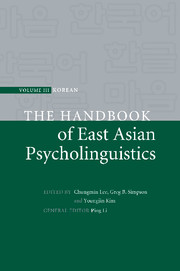Book contents
- Frontmatter
- Contents
- List of figures
- List of tables
- List of contributors
- Preface
- Introduction: Advances in Korean psycholinguistics
- Part I Language acquisition
- Part II Language processing
- 28 Visual processing of Hangul, the Korean script
- 29 English vowel spaces produced and perceived by Americans and Koreans
- 30 Morphological representation and processing of Sino-Korean words
- 31 The role of phonology in word recognition of Korean Hangul and Hanja
- 32 Lexical and sublexical processes in Korean word recognition
- 33 Prosody in sentence processing
- 34 Korean sentence processing
- 35 Sentence processing and memory representation in Korean
- 36 Understanding complex sentences: memory constraints and informational structure
- 37 ERP studies of Korean language processing: word-order effects
- 38 Inferences during discourse comprehension in Korean
- 39 Morpho-syntactic processing in Korean aphasics
- 40 Morpho-syntactic processing of Korean-speaking adults with Broca's aphasia
- 41 Comprehension deficits in Korean agrammatic aphasia
- 42 Developmental reading disorders in Korean
- 43 Individual differences in Korean language processing: context-dependent processing of skilled readers in word ambiguity resolution
- 44 A computational model of lexical and morphological processing in Korean
- References
- Name index
- Subject index
35 - Sentence processing and memory representation in Korean
from Part II - Language processing
Published online by Cambridge University Press: 05 June 2012
- Frontmatter
- Contents
- List of figures
- List of tables
- List of contributors
- Preface
- Introduction: Advances in Korean psycholinguistics
- Part I Language acquisition
- Part II Language processing
- 28 Visual processing of Hangul, the Korean script
- 29 English vowel spaces produced and perceived by Americans and Koreans
- 30 Morphological representation and processing of Sino-Korean words
- 31 The role of phonology in word recognition of Korean Hangul and Hanja
- 32 Lexical and sublexical processes in Korean word recognition
- 33 Prosody in sentence processing
- 34 Korean sentence processing
- 35 Sentence processing and memory representation in Korean
- 36 Understanding complex sentences: memory constraints and informational structure
- 37 ERP studies of Korean language processing: word-order effects
- 38 Inferences during discourse comprehension in Korean
- 39 Morpho-syntactic processing in Korean aphasics
- 40 Morpho-syntactic processing of Korean-speaking adults with Broca's aphasia
- 41 Comprehension deficits in Korean agrammatic aphasia
- 42 Developmental reading disorders in Korean
- 43 Individual differences in Korean language processing: context-dependent processing of skilled readers in word ambiguity resolution
- 44 A computational model of lexical and morphological processing in Korean
- References
- Name index
- Subject index
Summary
Introduction
When readers comprehend a sentence, they construct coherent mental models in memory. The mental models of sentences include various components: semantic roles, syntactic positions, pragmatic order, and so on. These components influence each other in order to construct a mental model of a sentence. One of the most important questions in the field of the psychology of language is how these components contribute to the representation and processing of a sentence.
Gernsbacher (1990) proposed a general cognitive framework to explain the process and representation of skilled language comprehension, called the Structure Building Framework (hereafter SBF). The SBF has three component processes: laying the foundation, mapping, and shifting. These processes operate with the incoming language information to build a mental model of a sentence. Gernsbacher claimed that these processing mechanisms could be applied to any information beyond language. The most important principle of laying the foundation is the advantage of ‘first mention’. This effect was obtained consistently in English using several variations of sentences. Based on the laying of the foundation, the activation of incoming information transmits a processing signal to enhance or suppress previous information. The processes develop a mental model by mapping and shifting for coherence between new and old information. The SBF has been supported by many empirical findings (see Gernsbacher, 1997).
The important question is whether the advantage of first mention is a universal phenomenon across languages or is applicable only to specific languages.
- Type
- Chapter
- Information
- The Handbook of East Asian Psycholinguistics , pp. 442 - 453Publisher: Cambridge University PressPrint publication year: 2009



